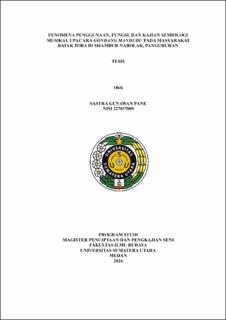| dc.description.abstract | This study examines a ritual ceremony in the Batak Toba community known as Mandudu. The Mandudu ritual ceremony must be accompanied by Gondang Sabangunan as the central element for approximately one hour without interruption, during which the participants must pray and refrain from dancing. This ceremony is an ancestral tradition of the Batak Toba community, performed by the Ruma Parsaktian Ompung Raja Isumbaon community in Sijambur Nabolak, Pangururan, Samosir Regency. The objective of this study is to describe the proceedings of the ceremony and to understand the usage, function, and semiological analysis of the Gondang Mandudu music performed by the Ruma Parsaktian Ompung Raja Isumbaon community in Sijambur Nabolak, Pangururan. The research method used is descriptive qualitative. The findings highlight a deep understanding of local beliefs, providing comprehensive insights into the significance of the ritual in the cultural and spiritual context of the Ruma Parsaktian Ompung Raja Isumbaon community. The main focus of the research is on the usage, function, and semiological analysis of the Gondang Mandudu ceremony as a highly sacred spiritual means to ward off evil during the COVID-19 pandemic. The theories used include the use and function theory regarding the usage and function of Gondang, and the theory of ritual components, which encompasses the location, time, objects, and tools of the ceremony, and its supporting elements. Additionally, the semiotic theory of music, comprising poietic, neutral or trace, and esthesic aspects, is applied. The results of the study indicate that the use of Gondang Mandudu encompasses spiritual and ritualistic dimensions, functioning as emotional expression, aesthetic appreciation, communication, symbolism, adherence to social norms, cultural continuity, and community integration. The semiological analysis of the music includes the process of selecting the repertoire for spiritual purposes to ward off evil (poietic), the prescriptive notation of the Manghuruk Gondang, Gondang Elek-Elek, and Gondang Parjonggi-Jonggina as sound materials (neutral/trace), and the interpretation of Gondang Mandudu as a means of contemplation, meditation, and personal or collective reflection on the essence of the universe and all its components, believed to originate from the Creator of the universe (esthesic). | en_US |


